
St Francis Xavier's Cathedral, Adelaide: exterior
[photograph from https://commons.wikimedia.org/wiki/File:Cathedral_103_046.jpg accessed 7 December 2016]

St Francis Xavier's Cathedral, Adelaide: exterior
[photograph from https://commons.wikimedia.org/wiki/File:Cathedral_103_046.jpg accessed 7 December 2016]
Historical and Technical Documentation by John Maidment
© OHTA, 2016, 2018 (last updated February 2018)
Distinguished British architect Charles Hansom produced the initial plans for the building as far back as 1845, in a simple Early-English Gothic idiom deriving from the medieval church at West Walton, Norfolk. In 1850, local architect Richard Lambeth won a competition for the design of a new Cathedral, based upon Hansom's initial designs. By 1860, the east end and four bays of the nave had been erected. In the 1880s, Pugin & Pugin, of Westminster, were engaged to plan the completion of the building, this including the widening of the 'north' aisle under seven transverse gables. These plans also included a new design for the 'western' façade with a rose window placed beneath a giant arch and a tower to the right. In 1886-87 the 'south' aisle was widened to match that on the 'north'. In 1922, local architect Walter Hervey Bagot produced revised plans for the main façade and these were implemented 1923-26, including the façade, narthex and tower base. The stump of the tower was raised to its full height in 1996, designed by Lynton Jury, but without the intended spire.1
First organ.
The first organ, built by J.W. Wolff, was opened in 1869:
The opening of the new organ in St Francis Xavier's Cathedral took place on Sunday Morning May 9 at 11 o'clock. The service commenced with solemn High Mass … Mr Lascelles presided during the whole of the Mass at the organ … Miss Morriss presided at the organ during the evening service. The organ is a magnificent instrument and entirely of colonial manufacture, being built by Mr J W Wolff, of Wakefield St. It contains the following 6 stops on the Manual:- Open diapason, stop diapason, principal. flute, dulciana, fifteenth, and coupler, with an independent [pedal] organ of two stops.2
Second organ.
On completion of the building of the nave, a new organ by J.E. Dodd was built in 1926 to the specification of Dr Harold Davies and Harold Wylde.3 It cost £1,986-10-0.4 It was placed in a chamber at an upper level in the base of the tower and spoke into the right-hand aisle (behind a 16ft front) and across the gallery. The console was located centrally in the gallery.
| GREAT Double Diapason Phonon Diapason Open Diapason Claribel Dulcissima Principal Harmonic Flute Fifteenth Tromba Great Sub Great Super Swell to Great Choir to Great |
16 8 8 8 8 4 4 2 8 |
A B # |
||
| SWELL Bourdon Open Diapason Hohl Flute Viol d'Gamba Celeste Principal Flauto Traverso Mixture Cornopean Oboe Tremulant Sub Octave Super Octave |
16 8 8 8 8 4 4 III 8 8 |
C |
||
| CHOIR Melodic Diapason Lieblich Gedact Viol d'Orchestre Dulciana Gemshorn Piccolo Clarinet Vox Humana Tremulant Sub Octave Super Octave Swell to Choir |
8 8 8 8 4 2 8 8 |
(enclosed – prepared-for) |
||
| PEDAL Major Bass Diapason Sub Bass Echo Bass Octave Bass Flute Trombone Great to Pedal Swell to Pedal Choir to Pedal |
16 16 16 16 8 8 16 |
D A E C D E B # |
Detached console
Tubular-pneumatic action5
# This rank was probably prepared for

St Francis Xavier's Cathedral, Adelaide: organ and console viewed across gallery after Walker rebuild
[photograph supplied by Dr Geoffrey Cox – source unknown]
The organ was rebuilt with electro-pneumatic action, new drawstop console and tonal additions by J.W. Walker & Sons Ltd, Ruislip, Mx in 1954, the firm's job number 2910, costing £5,270. Installation was carried out by the Dodd firm, with the voicing was carried out on site by Walter Goodey from the Walker firm. In April 1957, a replacement secondhand small Open Diapason stop was provided from Tenor F# upwards for £58.00. When the tower was extended to its full height in the 1990s, this organ was removed into storage by Leith Jacob where it still remains.
| GREAT Double Open Diapason Open Diapason No.1 Open Diapason No.2 Open Diapason No.3 Viola Wald Flute Octave Principal Harmonic Flute Fifteenth Full Mixture 17.19.22 Sharp Mixture 26.29 Trumpet Octave Trumpet Swell to Great Sub Swell to Great Swell to Great Super Choir to Great |
16 8 8 8 8 8 4 4 4 2 III II 8 4 |
A old Phonon Diapason A old Open Diapason no 2 new new A new new B new B new |
||
| SWELL Lieblich Bourdon Open Diapason Hohl Flute Viola da Gamba Voix Celeste Principal Flauto Traverso Fifteenth Mixture 15.19.22 Double Trumpet Cornopean Oboe Clarion Tremulant Swell Sub Octave Swell Unison Off Swell Super Octave |
16 8 8 8 8 4 4 2 III 16 8 8 4 |
C TC new remodelled D 1-12 new D D 1-12 new |
||
| CHOIR Contra Flute Violin Diapason Violoncello Rohr Flute Dulciana Prestant Lieblich Flute Dulcet Nazard Flautino Contra Clarinet Clarinet Tremulant Trumpet Tuba Octave Tuba Swell to Choir Sub Swell to Choir Swell to Choir Super |
16 8 8 8 8 4 4 4 2-2/3 2 16 8 8 8 4 |
(enclosed except Trumpet and Tuba) E TC new F new new E new G ex Great F new H new G H new H new I TC new I new B new J new J new |
||
| PEDAL Open Wood Open Diapason Bourdon Echo Bourdon Quint Principal Octave Bass Flute Octave Quint Fifteenth Octave Flute Mixture 19.22.26.29 Ophicleide Double Trumpet Clarion Great to Pedal Swell to Pedal Choir to Pedal |
16 16 16 16 10-2/3 8 8 8 5-1/3 4 4 IV 16 16 8 |
K A L C M new N new K L M new N new L new J new D 1-12 new B new |
Great & Pedal combinations coupled
Compass: 61/32
Electro-pneumatic and electro-magnetic action
Mechanical swell pedals
Detached drawstop console6
Present organ.
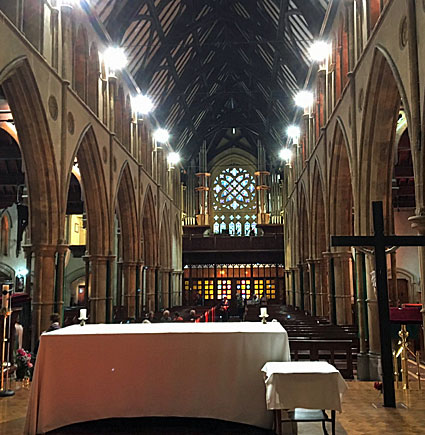
St Francis Xavier's Cathedral, Adelaide: Casavant organ viewed from the sanctuary
[photograph by John Maidment (16 November 2016)]
The current organ was built in 1927 by Casavant Frères, Ste-Hyacinthe, Quebec, opus 1225, for St Jean-de-le-Croix, Montreal, Canada. The work of rebuilding and restoration has been carried out by Melbourne organbuilders Wakeley Pipe Organs Pty Ltd working with architects Grieve Gillett Andersen. The organ is divided on either side of the rear gallery of the Cathedral behind newly constructed blackwood casework, its design deriving from architectural motifs in the building and providing an effective frame for the rose window and its Kempe glass.
It was opened at a recital given by Dr Joshua van Kolkelenberg on Tuesday 15 November 2016. His programme included works by Bach, Mendelssohn, Franck, Duruflé, Alain and Widor.
This is the first major example of an interwar church organ from the American continent to come to Australia. While instruments by Aeolian and Wurlitzer also came to Australia at the time, these were either far smaller or built on the extension principle, for cinemas and residences.
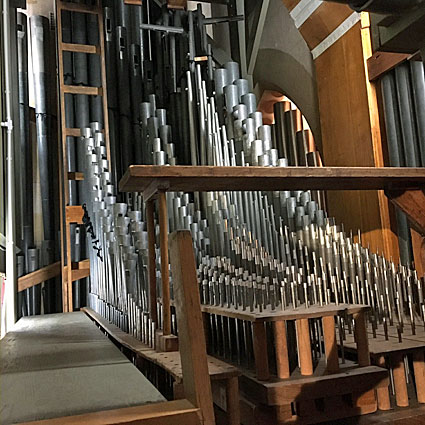
St Francis Xavier's Cathedral, Adelaide: lower Grand Orgue windchest and pipework, Casavant organ
[photograph by John Maidment (16 November 2016)]
The Casavant organ is notable for its extraordinary generosity of construction, with lavish use of thick timbers, huge swell boxes and windchests. The overall sound certainly has a French flavour, but with a greater sense of refinement and employing sonorities that would not have been heard in that country. There is a wealth of flute stops, of both wood and metal, and some of harmonic construction. The manual windchests are of 73-note compass, so clearly designed for the use of octave and sub-octave couplers. The heavy-pressure enclosed Solo division can be coupled to any of the three manuals, the Stentorphone (actually a large-scale Diapason, with leathered lips in the bass) and the Tuba Mirabilis, to give a welcome unison boost to the overall sound. The swell boxes are enormously effective and can cut the overall sound back to a mere whisper.
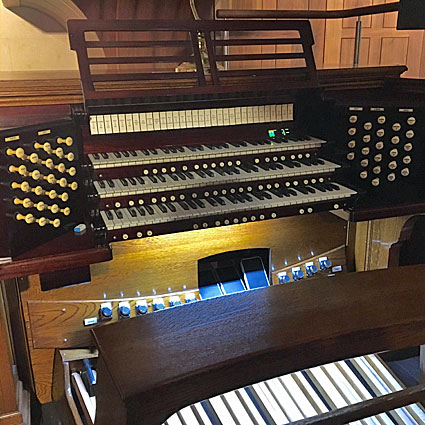
St Francis Xavier's Cathedral, Adelaide: console of Casavant organ
[photograph by John Maidment (16 November 2016)]
The low-profile drawstop console (with rocker tablets for the couplers) includes a Pedal Divide, a facility to alter the order of the manuals (inverting the Grand Orgue and Positif manuals), and very neat light-up swell indicators. The action throughout has been updated, with solid-state controls and a comprehensive combination action.
The three new Laukhuff blowers are located in a specially designed and insulated sound-proof room, hauling wind from the interior of the instrument, while a humidification plant by Watkins & Watson is also placed there – the room is air conditioned.
| GRAND ORGUE (II) Montre Montre Flûte Ouverte Flûte à Cheminée Gemshorn Prestant Flûte Harmonique Doublette Mixture Trompette Clairon Grand Orgue 16 Grand Orgue Unison Off Grand Orgue 4 Récit to Grand Orgue 16 Récit to Grand Orgue 8 Récit to Grand Orgue 4 Positif to Grand Orgue 16 Positif to Grand Orgue 8 Positif to Grand Orgue 4 Solo to Grand Orgue 8 |
16 8 8 8 8 4 4 2 1-1/3 IV 8 4 |
73 note chest A |
||
| RÉCIT (III) Bourdon Principal Bourdon Viole de Gambe Voix Céleste Prestant Flûte Traverse Piccolo Cornet Bombarde Trompette Hautbois Voix Humaine Clairon Trémolo Récit 16 Récit Unison Off Récit 4 Solo to Récit 8 |
16 8 8 8 8 4 4 2 2 IV 16 8 8 8 4 |
73 note chest - enclosed B to CC |
||
| POSITIF (I) Bourdon Diapason Melodie Dulciana Flûte Douce Violina Nazard Piccolo Clarinette Trémolo Positif 16 Positif Unison Off Positif 4 Récit to Positif 16 Récit to Positif 8 Récit to Positif 4 Solo to Positif 8 |
16 8 8 8 4 4 2-2/3 2 8 |
73 note chest – enclosed |
||
| SOLO Stentorphone Grosse Flûte Viole d'Orchestre Tuba Mirabilis |
8 8 8 8 |
floating – 73 note chest – pipes in Positif enclosure |
||
| PÉDALE Basse Résultante Flûte Ouverte Open Diapason Bourdon Violon Bourdon Doux Flûte Bourdon Bombarde Trompette Pédale Unison Off Pédale Divide Grand Orgue to Pédale 8 Récit to Pédale 8 Récit to Pédale 4 Positif to Pédale 8 Positif to Pédale 4 Solo to Pédale 8 |
32 16 16 16 16 16 8 8 16 8 |
12 independent Quint pipes C A D B C D E E |
Compass: 61/32
Electro-pneumatic action
Detached drawstop console with stopkeys for the couplers
Electro-pneumatic swell pedals to Récit and Positif/Solo operating whiffle-tree swell engines
Mixture Compositions
Grand Orgue Mixture:
C1-B24 15.17.19.22
C25-F42 12.15.17.19
F#43-B48 8.12.12.17
C49-C61 1.5.8.12
C#62-C73 1.5.8.5
Récit Cornet:
C1-C49 8.12.15.17
C#50-C61 8.12.8.10
C#62-C73 8.5.8.10
Wind Pressures
Grand Orgue 5½"
Récit (LP) 7"
Récit (HP) 10" (chorus reeds)
Positif 6"
Solo 12"
Pedale 6" & 7"7
1 Information very kindly supplied by Brian Andrews, deriving from his paper 'A pleasing old-time appearance': Peter Paul Pugin and St Francis Xavier's Cathedral, Adelaide' published by the Pugin Society in 2005.
2 SA Advertiser, Monday May 10 1869, p 2.6
3 Southern Cross,16 April 1926
4 J.E Dodd Ledger 1925, p.28
5 M.J.A. Whiting, Collection of Specifications, cited in Bruce Allan Naylor, Gazetteer of Organs in South Australia, September 1969, pp 24-25
6 The 1954 specification and details supplied by R.J. Pennells, J.W. Walker & Sons Ltd, Brandon, Suffolk, to John Maidment from the firm's records, c.2005
7 Details of the Casavant organ kindly supplied by Ian Wakeley and from the author's notes

St Francis Xavier's Cathedral, Adelaide: Solo pipework, Tuba Mirabilis at bottom, Casavant organ
[photograph by John Maidment (16 November 2016)]
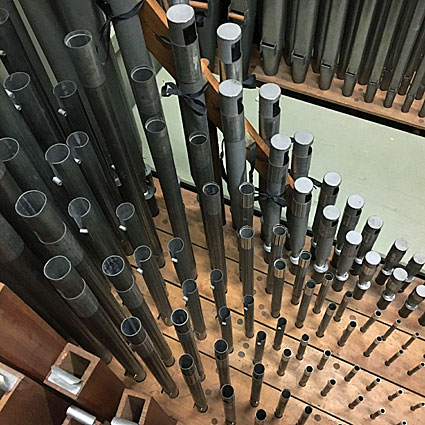
St Francis Xavier's Cathedral, Adelaide: Positif pipework, Casavant organ
[photograph by John Maidment (16 November 2016)]

St Francis Xavier's Cathedral, Adelaide: Pédale Flûte Ouverte pipework, Casavant organ
[photograph by John Maidment (16 November 2016)]
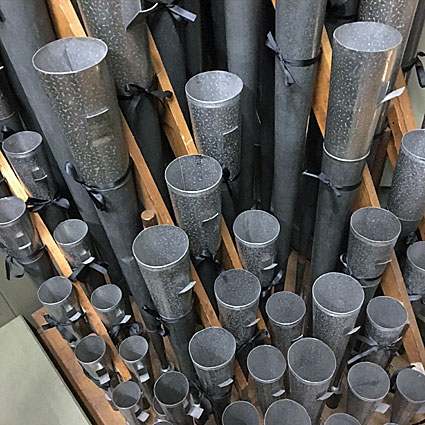
St Francis Xavier's Cathedral, Adelaide: Récit chorus reeds, Casavant organ
[photograph by John Maidment (16 November 2016)]
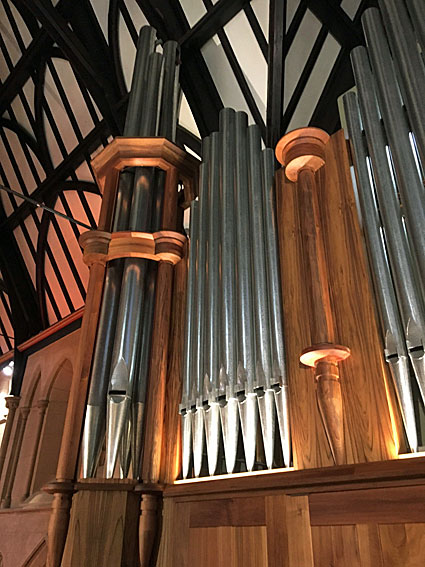
St Francis Xavier's Cathedral, Adelaide: casework detail, Casavant organ
[photograph by John Maidment (16 November 2016)]
______________________________________
POSTSCRIPT
Further accounts of the Casavant organ can be found in:
• Ian Wakeley, Monte Pemberton, Kate Buttery & Ian Hamilton, 'Montreal to Adelaide: A Symphonic Organ Reform,' The Sydney Organ Journal, vol. 47, no. 3 (Winter 2016), pp. 22-27.
• Rachel Wall, 'The Casavant from Canada,' Organ Australia, (Edition Two 2017), pp. 12-15.